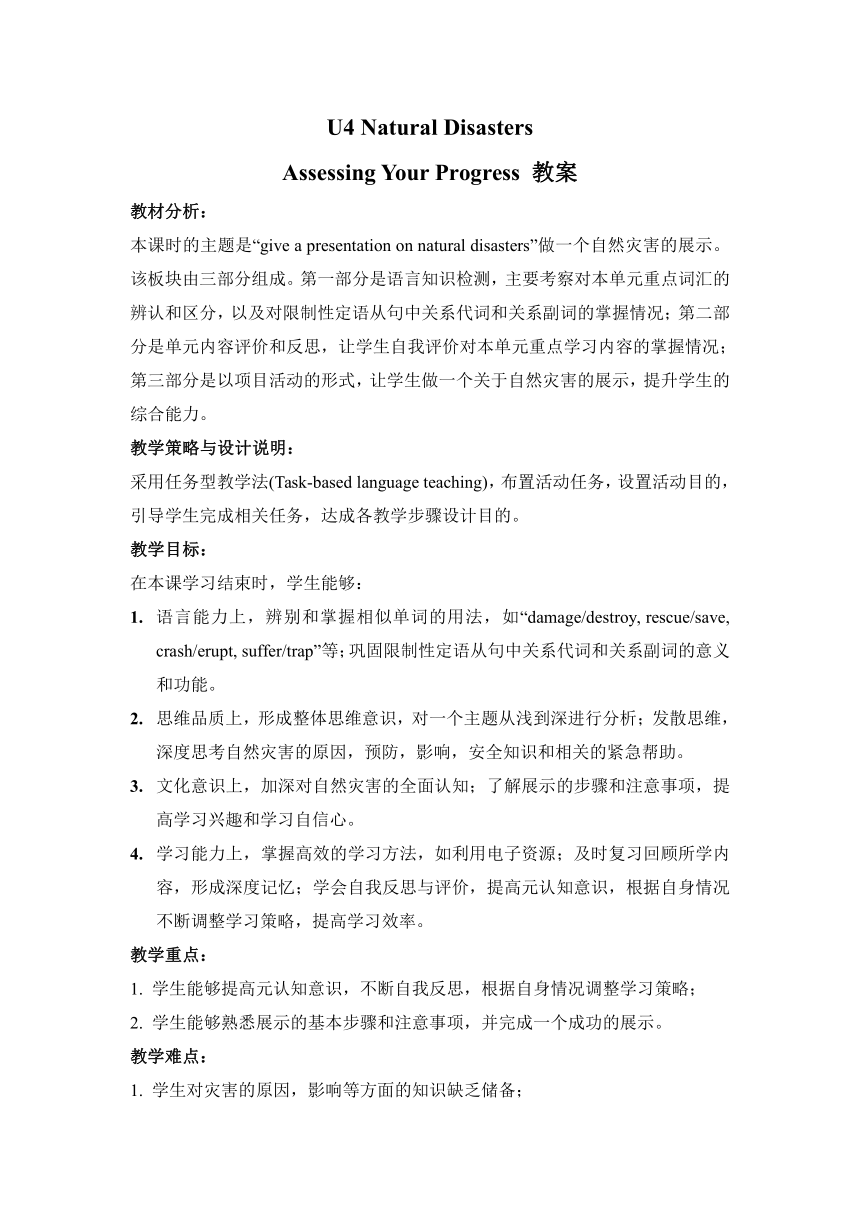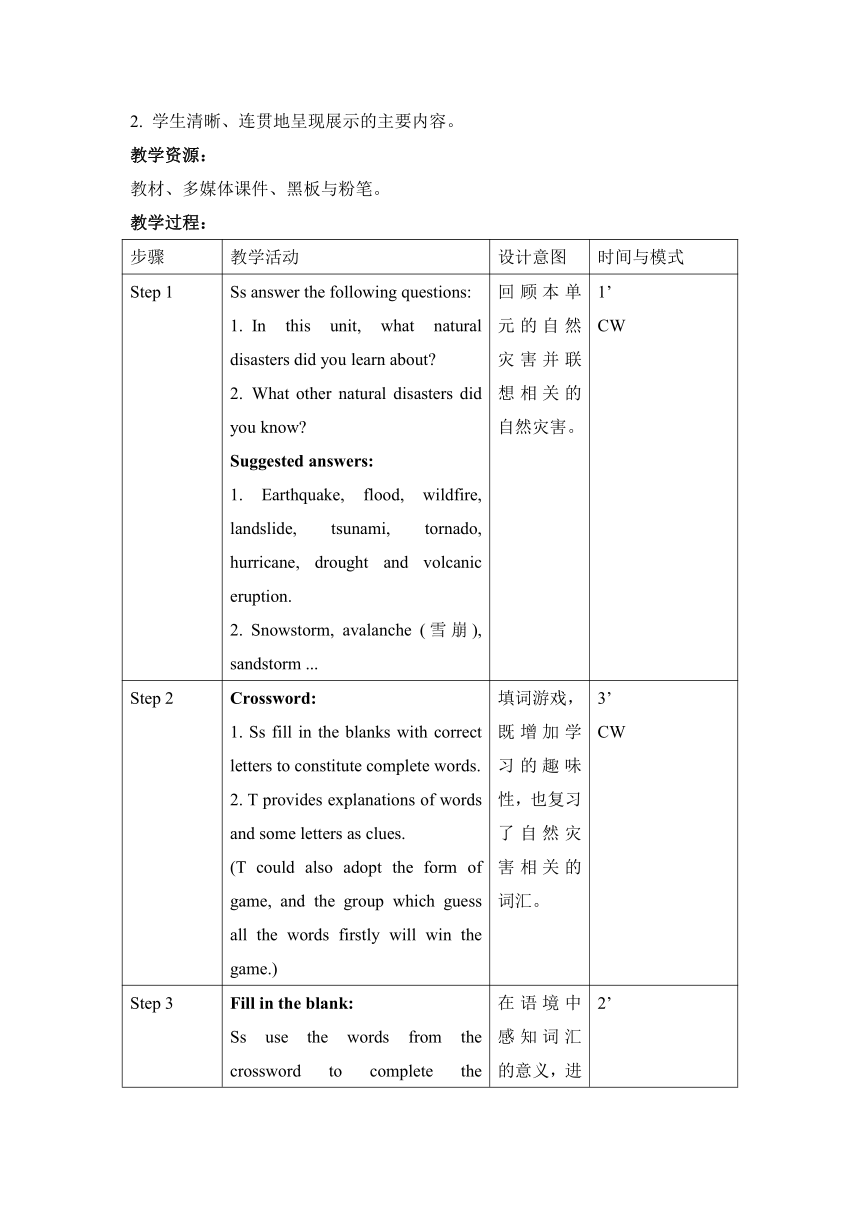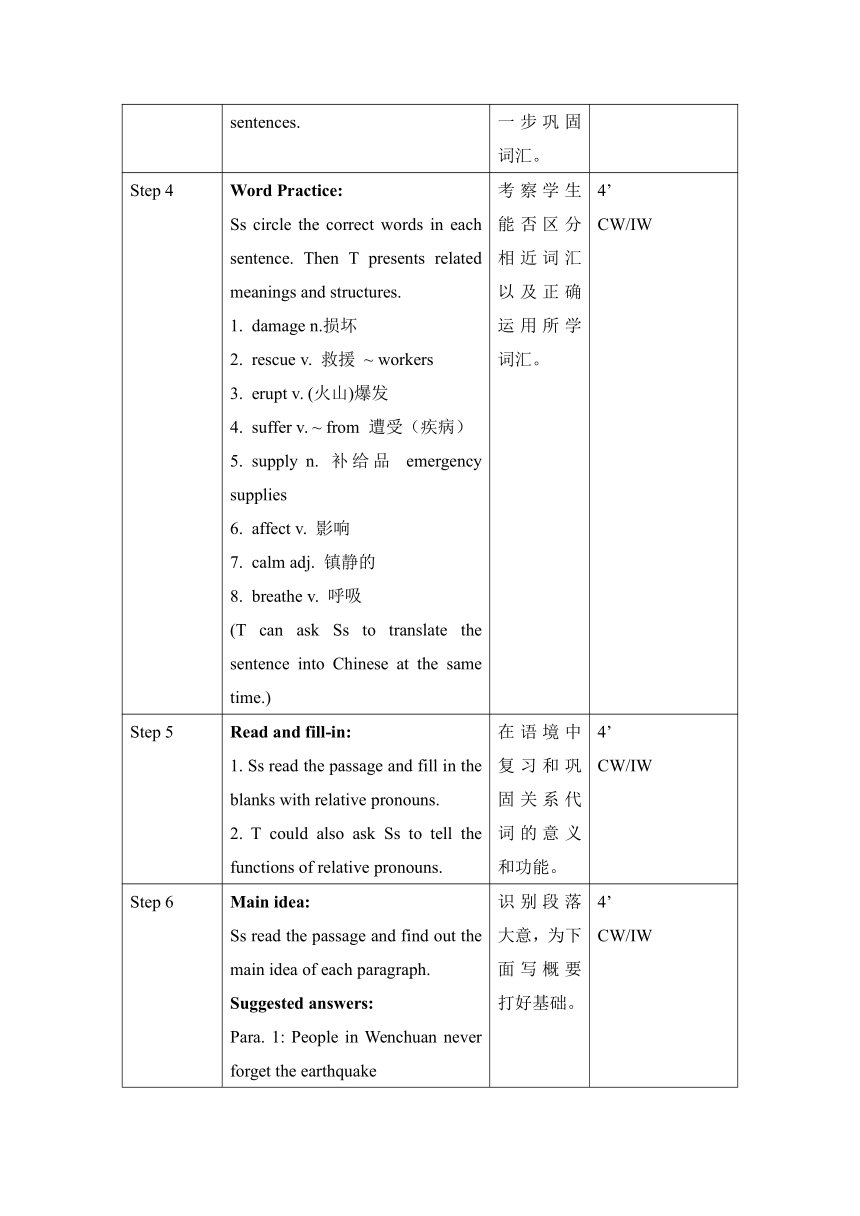人教版(2019)必修 第一册Unit 4 Natural disasters Assessing Your Progress 教案(表格式)
文档属性
| 名称 | 人教版(2019)必修 第一册Unit 4 Natural disasters Assessing Your Progress 教案(表格式) |  | |
| 格式 | docx | ||
| 文件大小 | 14.5KB | ||
| 资源类型 | 教案 | ||
| 版本资源 | 人教版(2019) | ||
| 科目 | 英语 | ||
| 更新时间 | 2024-03-31 16:36:25 | ||
图片预览




文档简介
U4 Natural Disasters
Assessing Your Progress 教案
教材分析:
本课时的主题是“give a presentation on natural disasters”做一个自然灾害的展示。该板块由三部分组成。第一部分是语言知识检测,主要考察对本单元重点词汇的辨认和区分,以及对限制性定语从句中关系代词和关系副词的掌握情况;第二部分是单元内容评价和反思,让学生自我评价对本单元重点学习内容的掌握情况;第三部分是以项目活动的形式,让学生做一个关于自然灾害的展示,提升学生的综合能力。
教学策略与设计说明:
采用任务型教学法(Task-based language teaching),布置活动任务,设置活动目的,引导学生完成相关任务,达成各教学步骤设计目的。
教学目标:
在本课学习结束时,学生能够:
语言能力上,辨别和掌握相似单词的用法,如“damage/destroy, rescue/save, crash/erupt, suffer/trap”等;巩固限制性定语从句中关系代词和关系副词的意义和功能。
思维品质上,形成整体思维意识,对一个主题从浅到深进行分析;发散思维,深度思考自然灾害的原因,预防,影响,安全知识和相关的紧急帮助。
文化意识上,加深对自然灾害的全面认知;了解展示的步骤和注意事项,提高学习兴趣和学习自信心。
学习能力上,掌握高效的学习方法,如利用电子资源;及时复习回顾所学内容,形成深度记忆;学会自我反思与评价,提高元认知意识,根据自身情况不断调整学习策略,提高学习效率。
教学重点:
学生能够提高元认知意识,不断自我反思,根据自身情况调整学习策略;
学生能够熟悉展示的基本步骤和注意事项,并完成一个成功的展示。
教学难点:
学生对灾害的原因,影响等方面的知识缺乏储备;
学生清晰、连贯地呈现展示的主要内容。
教学资源:
教材、多媒体课件、黑板与粉笔。
教学过程:
步骤 教学活动 设计意图 时间与模式
Step 1 Ss answer the following questions: In this unit, what natural disasters did you learn about What other natural disasters did you know Suggested answers: 1. Earthquake, flood, wildfire, landslide, tsunami, tornado, hurricane, drought and volcanic eruption. 2. Snowstorm, avalanche (雪崩), sandstorm ... 回顾本单元的自然灾害并联想相关的自然灾害。 1’ CW
Step 2 Crossword: 1. Ss fill in the blanks with correct letters to constitute complete words. 2. T provides explanations of words and some letters as clues. (T could also adopt the form of game, and the group which guess all the words firstly will win the game.) 填词游戏,既增加学习的趣味性,也复习了自然灾害相关的词汇。 3’ CW
Step 3 Fill in the blank: Ss use the words from the crossword to complete the sentences. 在语境中感知词汇的意义,进一步巩固词汇。 2’
Step 4 Word Practice: Ss circle the correct words in each sentence. Then T presents related meanings and structures. damage n.损坏 rescue v. 救援 ~ workers erupt v. (火山)爆发 suffer v. ~ from 遭受(疾病) supply n. 补给品 emergency supplies affect v. 影响 calm adj. 镇静的 breathe v. 呼吸 (T can ask Ss to translate the sentence into Chinese at the same time.) 考察学生能否区分相近词汇以及正确运用所学词汇。 4’ CW/IW
Step 5 Read and fill-in: 1. Ss read the passage and fill in the blanks with relative pronouns. 2. T could also ask Ss to tell the functions of relative pronouns. 在语境中复习和巩固关系代词的意义和功能。 4’ CW/IW
Step 6 Main idea: Ss read the passage and find out the main idea of each paragraph. Suggested answers: Para. 1: People in Wenchuan never forget the earthquake on 12 May, 2018. Para. 2: People are living a new life now. 识别段落大意,为下面写概要打好基础。 4’ CW/IW
Step 7 Summary: 1. Ss write a summary for the short text. 2. After Ss finish the summary, T presents a sample: People in Wenchuan never forget the earthquake on 12 May, 2018. Now, they are living a new life with gratitude to rescue workers. Wenchuan has become a symbol of the Chinese spirit of never giving up. 复习和巩固概要写作的方法。 4’ IW
Step 8 Reflecting: T asks Ss to think about the following questions: 1. What did you learn about natural disasters in this unit that you did not know before 2. What else do you want to know about natural disasters 3. What did you find the most difficult in this unit 4. What in this unit motivated you most 5. Overall, I thought this unit was: Suggested answers: 1. Safety instructions, emergency kit, ... 2. How people recover from natural disasters; How to predict natural disasters; ... 3. Restrictive relative clauses, write a summary, ... 4. Report a natural disaster, prepare for a disaster, ... 5. interesting, useful, so-so, or difficult 学生自我评价对本单元的掌握情况,有助于学生形成课后自我反思的良好学习习惯; 提升学生的原认知意识和元认知策略,帮助学生解决学习困难,增强学生学习自信心。 5’ IW/CW
Step 9 Watch a video: T plays a video, giving some helpful tips to Ss. (T could ask Ss what they can learn from the video. Possible answers: be prepared; tell a story; watch your postures and gestures...) 让学生对做展示有个初步的认知。 2’ GW/CW
Step 10 Group work: Ss work in groups, choose a natural disaster and brainstorm the answers of the following questions: Understanding the disaster: Are there any causes of the disaster What can be done to prevent it Preparing for the disaster: What are the possible effects of the disaster What can be done to prepare for it In the event of the disaster: What can you do to stay safe during the disaster What kind of help do survivors need T gives sample answers through pictures and the pie chart. Example: Wildfire Cause: general public, arson, agricultural operation... Prevention: do not drive vehicles on dry grasses; do not toss cigarette butts... Effects: kills wide mass of animals and landscapes in the area; cause harms on human’s heath... Preparation: keep grass short and watered; reduce density of surrounding forest; have an emergency bag of your personal items... Safety instruction: listen to local radio or TV station for updated information; follow evacuation instructions... Helps for the survivors: donating money and supplies; providing volunteers... Ss can use the Internet and the school library to search for more information. (T leads Ss to compare the school library and the Internet from the perspectives of convenience, data, time and money. Convenience: it’s slow and complicated to use/it’s fast and easy to use Data: limited/wide and comprehensive Time: close after hours/available all the time Money: free/often not free) Ss put together a presentation using the information they gathered by themselves. Ss gives a presentation to the class. 通过呈现图片和饼状图,使得展示的呈现更加直观;为学生制作展示提供范例,使得任务更具操作性。 15’ GW
Step 11 Homework: Make a presentation on another natural disaster. 熟悉和巩固做展示的方法。 1’ CW
备注:
Ss: Students T: Teacher
IW: Individual work GW: Group work CW: Class work
教学反思
通过本节内容学习,学生是否巩固和熟练运用所学重点词汇、限制性定语从句和概要写作;
通过本节内容学习,学生能否通过合作,呈现一个有趣,内容丰富,简洁的展示;
通过本节内容学习,学生能否高效利用学习资源,如图书,网络;
深入反思学习成果,提高元认知意识,根据自身情况及时调整学习策略;形成整体思维意识,由浅入深地分析问题。
Assessing Your Progress 教案
教材分析:
本课时的主题是“give a presentation on natural disasters”做一个自然灾害的展示。该板块由三部分组成。第一部分是语言知识检测,主要考察对本单元重点词汇的辨认和区分,以及对限制性定语从句中关系代词和关系副词的掌握情况;第二部分是单元内容评价和反思,让学生自我评价对本单元重点学习内容的掌握情况;第三部分是以项目活动的形式,让学生做一个关于自然灾害的展示,提升学生的综合能力。
教学策略与设计说明:
采用任务型教学法(Task-based language teaching),布置活动任务,设置活动目的,引导学生完成相关任务,达成各教学步骤设计目的。
教学目标:
在本课学习结束时,学生能够:
语言能力上,辨别和掌握相似单词的用法,如“damage/destroy, rescue/save, crash/erupt, suffer/trap”等;巩固限制性定语从句中关系代词和关系副词的意义和功能。
思维品质上,形成整体思维意识,对一个主题从浅到深进行分析;发散思维,深度思考自然灾害的原因,预防,影响,安全知识和相关的紧急帮助。
文化意识上,加深对自然灾害的全面认知;了解展示的步骤和注意事项,提高学习兴趣和学习自信心。
学习能力上,掌握高效的学习方法,如利用电子资源;及时复习回顾所学内容,形成深度记忆;学会自我反思与评价,提高元认知意识,根据自身情况不断调整学习策略,提高学习效率。
教学重点:
学生能够提高元认知意识,不断自我反思,根据自身情况调整学习策略;
学生能够熟悉展示的基本步骤和注意事项,并完成一个成功的展示。
教学难点:
学生对灾害的原因,影响等方面的知识缺乏储备;
学生清晰、连贯地呈现展示的主要内容。
教学资源:
教材、多媒体课件、黑板与粉笔。
教学过程:
步骤 教学活动 设计意图 时间与模式
Step 1 Ss answer the following questions: In this unit, what natural disasters did you learn about What other natural disasters did you know Suggested answers: 1. Earthquake, flood, wildfire, landslide, tsunami, tornado, hurricane, drought and volcanic eruption. 2. Snowstorm, avalanche (雪崩), sandstorm ... 回顾本单元的自然灾害并联想相关的自然灾害。 1’ CW
Step 2 Crossword: 1. Ss fill in the blanks with correct letters to constitute complete words. 2. T provides explanations of words and some letters as clues. (T could also adopt the form of game, and the group which guess all the words firstly will win the game.) 填词游戏,既增加学习的趣味性,也复习了自然灾害相关的词汇。 3’ CW
Step 3 Fill in the blank: Ss use the words from the crossword to complete the sentences. 在语境中感知词汇的意义,进一步巩固词汇。 2’
Step 4 Word Practice: Ss circle the correct words in each sentence. Then T presents related meanings and structures. damage n.损坏 rescue v. 救援 ~ workers erupt v. (火山)爆发 suffer v. ~ from 遭受(疾病) supply n. 补给品 emergency supplies affect v. 影响 calm adj. 镇静的 breathe v. 呼吸 (T can ask Ss to translate the sentence into Chinese at the same time.) 考察学生能否区分相近词汇以及正确运用所学词汇。 4’ CW/IW
Step 5 Read and fill-in: 1. Ss read the passage and fill in the blanks with relative pronouns. 2. T could also ask Ss to tell the functions of relative pronouns. 在语境中复习和巩固关系代词的意义和功能。 4’ CW/IW
Step 6 Main idea: Ss read the passage and find out the main idea of each paragraph. Suggested answers: Para. 1: People in Wenchuan never forget the earthquake on 12 May, 2018. Para. 2: People are living a new life now. 识别段落大意,为下面写概要打好基础。 4’ CW/IW
Step 7 Summary: 1. Ss write a summary for the short text. 2. After Ss finish the summary, T presents a sample: People in Wenchuan never forget the earthquake on 12 May, 2018. Now, they are living a new life with gratitude to rescue workers. Wenchuan has become a symbol of the Chinese spirit of never giving up. 复习和巩固概要写作的方法。 4’ IW
Step 8 Reflecting: T asks Ss to think about the following questions: 1. What did you learn about natural disasters in this unit that you did not know before 2. What else do you want to know about natural disasters 3. What did you find the most difficult in this unit 4. What in this unit motivated you most 5. Overall, I thought this unit was: Suggested answers: 1. Safety instructions, emergency kit, ... 2. How people recover from natural disasters; How to predict natural disasters; ... 3. Restrictive relative clauses, write a summary, ... 4. Report a natural disaster, prepare for a disaster, ... 5. interesting, useful, so-so, or difficult 学生自我评价对本单元的掌握情况,有助于学生形成课后自我反思的良好学习习惯; 提升学生的原认知意识和元认知策略,帮助学生解决学习困难,增强学生学习自信心。 5’ IW/CW
Step 9 Watch a video: T plays a video, giving some helpful tips to Ss. (T could ask Ss what they can learn from the video. Possible answers: be prepared; tell a story; watch your postures and gestures...) 让学生对做展示有个初步的认知。 2’ GW/CW
Step 10 Group work: Ss work in groups, choose a natural disaster and brainstorm the answers of the following questions: Understanding the disaster: Are there any causes of the disaster What can be done to prevent it Preparing for the disaster: What are the possible effects of the disaster What can be done to prepare for it In the event of the disaster: What can you do to stay safe during the disaster What kind of help do survivors need T gives sample answers through pictures and the pie chart. Example: Wildfire Cause: general public, arson, agricultural operation... Prevention: do not drive vehicles on dry grasses; do not toss cigarette butts... Effects: kills wide mass of animals and landscapes in the area; cause harms on human’s heath... Preparation: keep grass short and watered; reduce density of surrounding forest; have an emergency bag of your personal items... Safety instruction: listen to local radio or TV station for updated information; follow evacuation instructions... Helps for the survivors: donating money and supplies; providing volunteers... Ss can use the Internet and the school library to search for more information. (T leads Ss to compare the school library and the Internet from the perspectives of convenience, data, time and money. Convenience: it’s slow and complicated to use/it’s fast and easy to use Data: limited/wide and comprehensive Time: close after hours/available all the time Money: free/often not free) Ss put together a presentation using the information they gathered by themselves. Ss gives a presentation to the class. 通过呈现图片和饼状图,使得展示的呈现更加直观;为学生制作展示提供范例,使得任务更具操作性。 15’ GW
Step 11 Homework: Make a presentation on another natural disaster. 熟悉和巩固做展示的方法。 1’ CW
备注:
Ss: Students T: Teacher
IW: Individual work GW: Group work CW: Class work
教学反思
通过本节内容学习,学生是否巩固和熟练运用所学重点词汇、限制性定语从句和概要写作;
通过本节内容学习,学生能否通过合作,呈现一个有趣,内容丰富,简洁的展示;
通过本节内容学习,学生能否高效利用学习资源,如图书,网络;
深入反思学习成果,提高元认知意识,根据自身情况及时调整学习策略;形成整体思维意识,由浅入深地分析问题。
